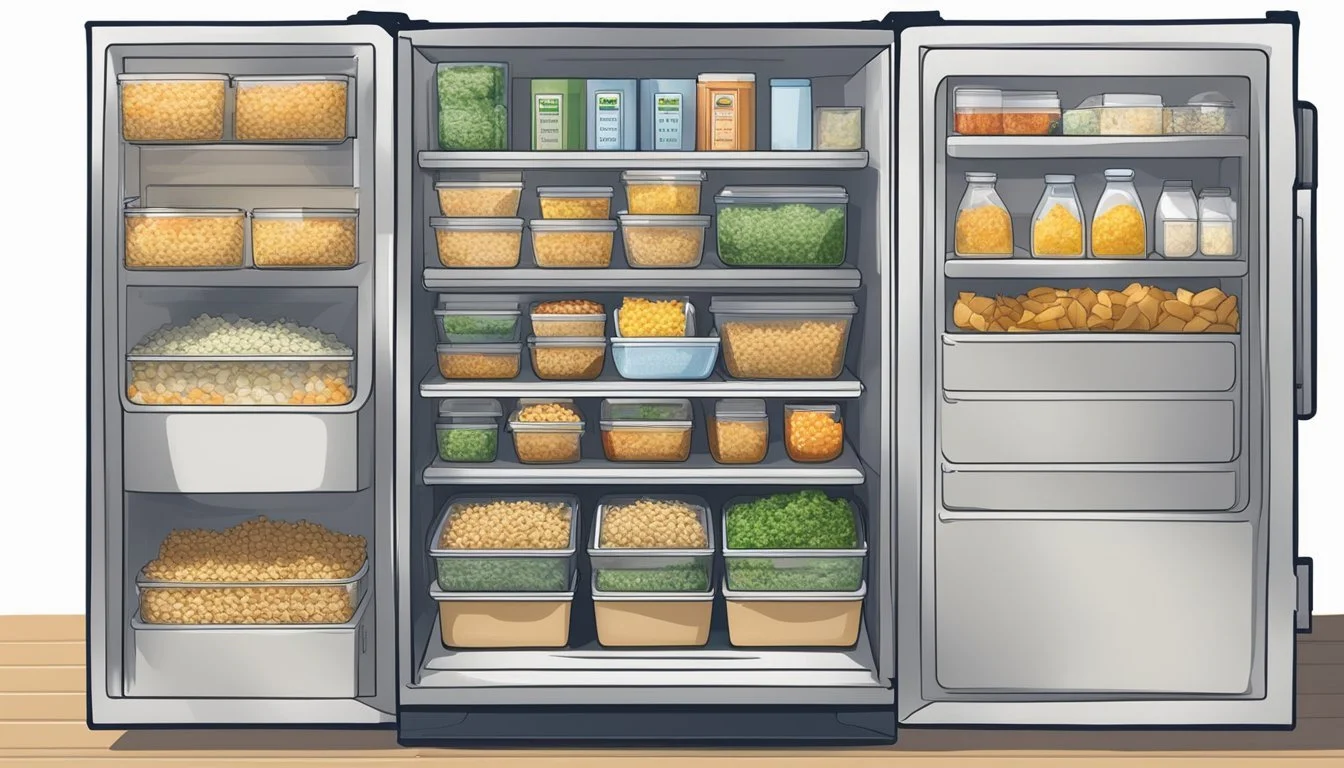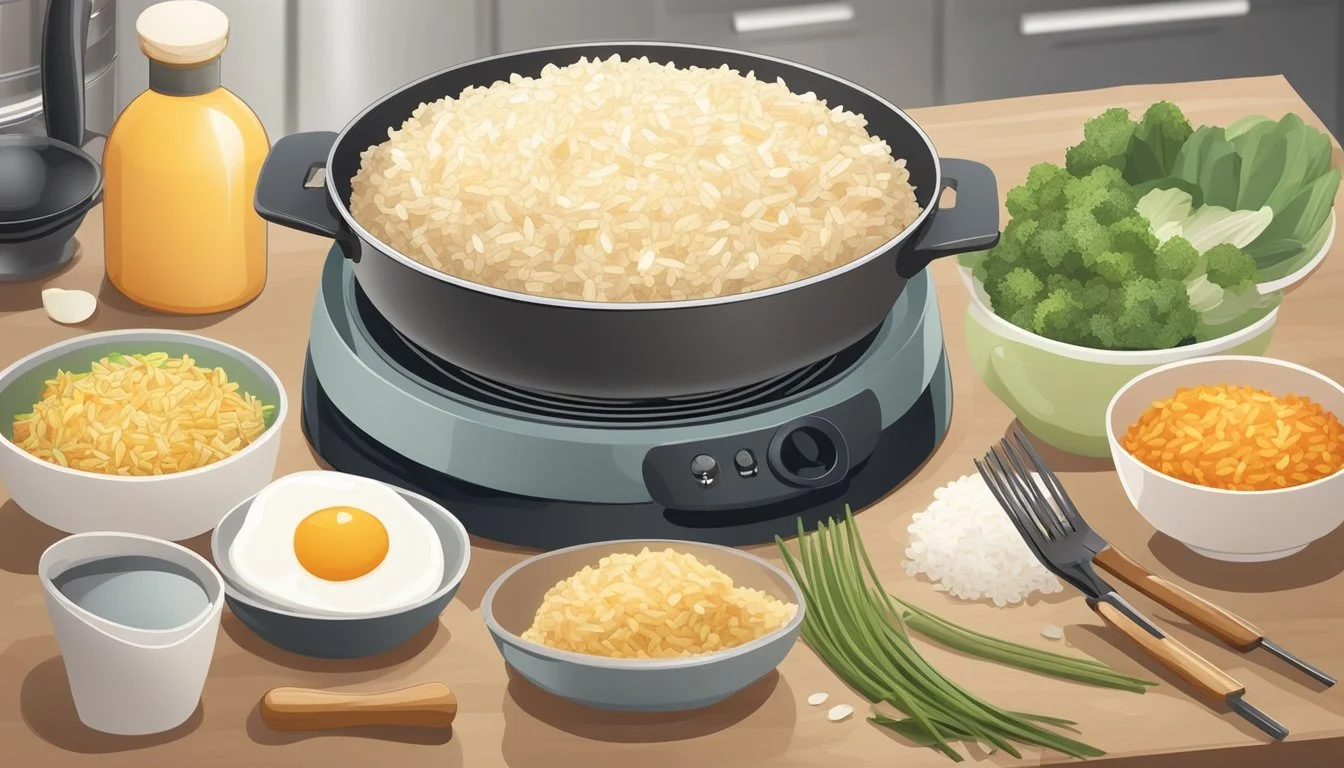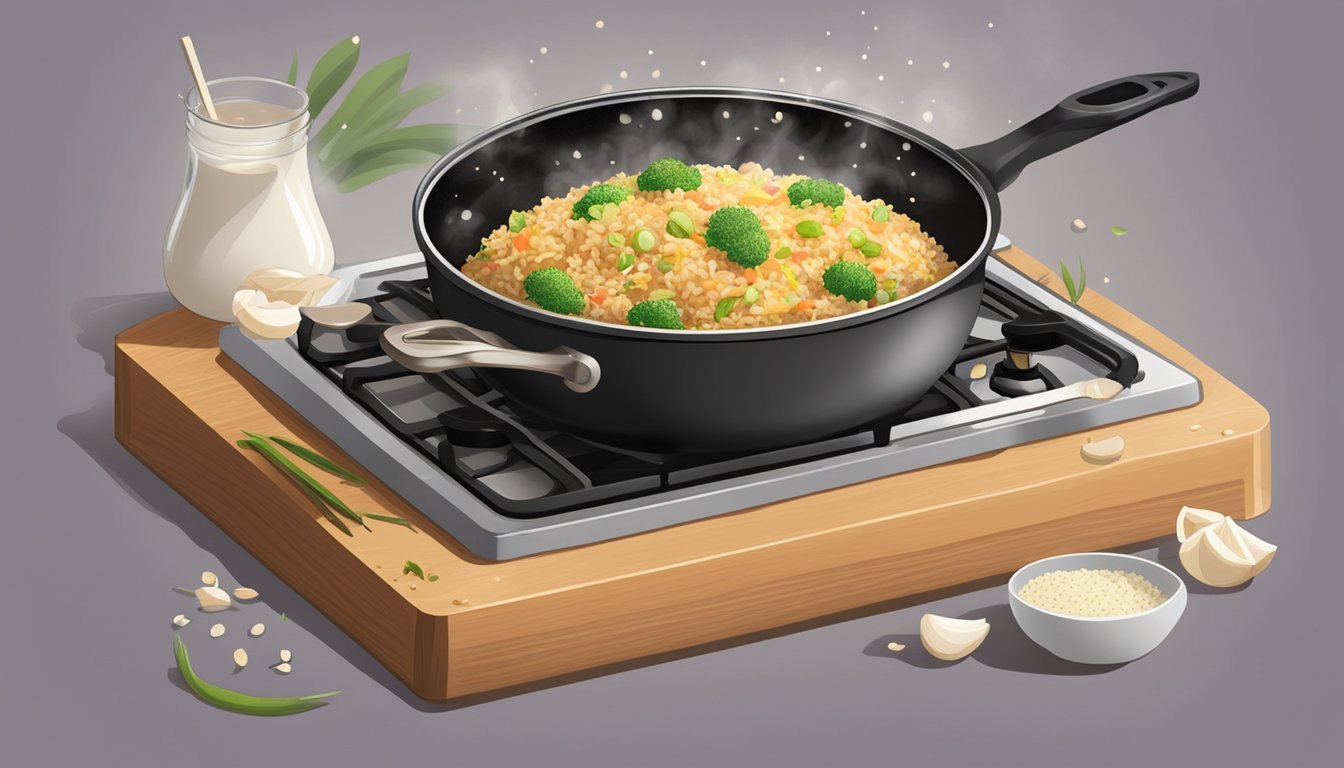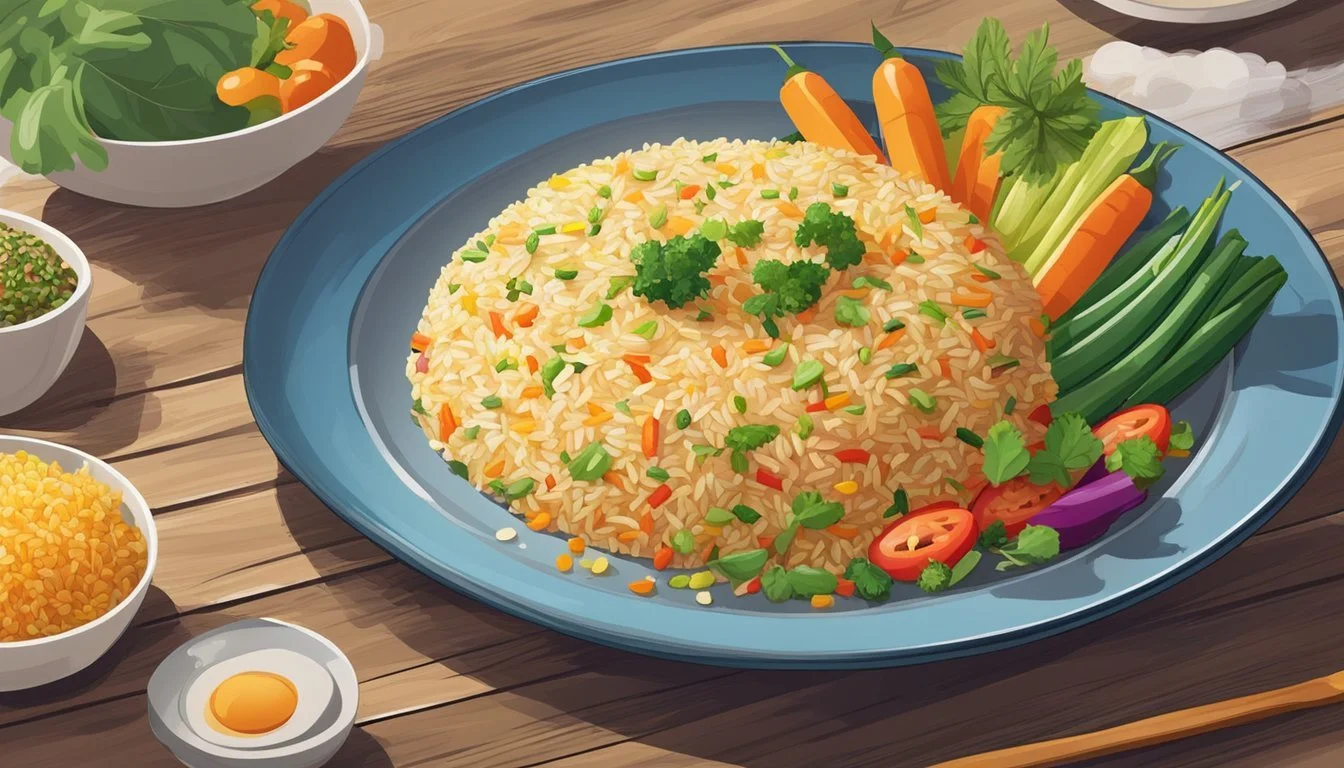How Long Does Fried Rice Last?
Storage Tips and Shelf Life Explained
Fried rice is a versatile dish enjoyed by many, but how long can it safely be kept? Fried rice can last in the refrigerator for approximately 4 to 7 days when stored properly. This makes it a convenient option for meal prepping or saving leftovers from your favorite takeaway.
Proper storage is key to maintaining the quality and safety of fried rice. It should be placed in airtight containers to prevent moisture and contaminants from shortening its shelf life. Reheating the rice thoroughly before consuming is crucial to avoid any potential foodborne illnesses.
Additionally, freezing is a viable option for even longer storage. When frozen in airtight containers or freezer bags, fried rice can maintain its quality for up to six months. This makes it easy to enjoy a quick and tasty meal anytime without the worry of spoilage.
Understanding Fried Rice and Food Safety
Fried rice is a popular dish, but it carries certain health risks if not handled properly. Bacillus cereus, a type of bacteria, can cause foodborne illnesses when food is improperly stored.
Leftover fried rice should be refrigerated promptly at temperatures below 40°F (4°C) to reduce bacterial growth.
Key points for food safety:
Storage Duration: Fried rice can last in the fridge for 4-7 days.
Freezing Options: For longer storage, fried rice can be frozen for up to 6 months.
Reheating: Reheat leftover fried rice thoroughly, ensuring it reaches an internal temperature of 165°F (74°C).
Health Risks
Bacillus cereus: Often linked to improperly stored rice, this bacteria can produce toxins that cause foodborne illnesses.
Symptoms: Includes nausea, vomiting, and diarrhea, typically within a few hours of consumption.
Proper food handling practices, including prompt refrigeration and thorough reheating, are crucial in minimizing health risks. This ensures that fried rice remains safe and enjoyable to eat.
Storage Guidelines for Fried Rice
Proper storage can significantly extend the shelf life of fried rice while minimizing the risk of foodborne illnesses. Learn how to refrigerate and freeze fried rice effectively, and find out which containers are best for keeping it fresh.
Refrigeration and Freezing
Fried rice should be stored in the fridge at a temperature between 35 and 40 degrees Fahrenheit (1.6-4.4 degrees Celsius). When stored properly, fried rice can last 4 to 7 days in the refrigerator. Freezing is a viable option for longer storage, allowing fried rice to be kept for up to 3 months.
It's crucial to let the fried rice cool to room temperature before placing it in the fridge or freezer. Promptly refrigerate cooked fried rice within two hours of preparation to prevent bacterial growth.
Containers and Packaging
Using airtight containers is essential for preserving the quality and safety of fried rice. Airtight containers or resealable plastic bags are ideal for refrigeration, as they prevent moisture and bacteria from accessing the food.
Freezer bags are recommended for freezing fried rice. These bags are specifically designed to prevent freezer burn, which can compromise the texture and taste. Label each container or bag with the date it was stored to keep track of its shelf life. Resealable options allow for easy access and resealing, helping maintain freshness each time a portion is taken out.
Optimal Conditions to Preserve Fried Rice
To maintain the quality of fried rice, it is crucial to store it under optimal conditions.
Refrigerated Storage: Store fried rice in the refrigerator at a consistent temperature between 35°F and 40°F (1.6°C to 4.4°C). This prevents the growth of bacteria and ensures the fried rice remains safe to eat.
Containers: Use airtight containers made of glass or food-grade plastic. Glass is preferred as it minimizes the risk of condensation that can lead to moisture buildup, which can spoil the rice.
Prompt Storage: Immediately refrigerate the fried rice after cooking. Leaving it at room temperature for too long can increase the risk of bacterial growth.
Environment: Place the container at the back of the fridge where the temperature is more consistent. Avoid putting it in the fridge door since the temperature fluctuates frequently.
Moisture Control: Ensure the fried rice is cooled before sealing the container to prevent excess moisture from forming. Excess moisture can lead to a soggy texture and increase the risk of spoilage.
Temperature Consistency: Check the refrigerator temperature regularly to make sure it stays within the recommended range. Consistent temperature is key to preserving the quality of fried rice.
Identifying Spoilage and Ensuring Consumption Safety
Properly identifying signs of spoilage and knowing how to prevent foodborne illnesses are crucial to safely consuming fried rice.
Signs of Spoilage
Identifying spoiled fried rice involves several key indicators. Texture is one of the first aspects to check; if the rice feels slimy or sticky beyond its usual consistency, it may be spoiling. Discoloration is another telltale sign; look for any unusual color changes, particularly green, blue, or black spots which could indicate mold. Unpleasant odors, such as sour or musty smells, are strong indicators that the rice is no longer safe to eat.
Detecting these signs early can help prevent foodborne illnesses. Examine fried rice closely before consuming, focusing on texture, color, and smell to ensure it is fresh.
Preventing Foodborne Illnesses
Preventing foodborne illnesses starts with proper storage. Refrigerate fried rice within two hours of cooking to slow bacterial growth. Keep the fridge temperature at or below 40°F (4°C). For longer-term storage, freeze the rice, ensuring it is in airtight containers to prevent moisture build-up and freezer burn.
Reheating fried rice to an internal temperature of 165°F (74°C) before consuming is crucial. Using a food thermometer can ensure this accuracy. Also, consume refrigerated fried rice within 3-4 days to avoid health risks such as nausea and diarrhea. Refer to Foodsafety.gov for more guidelines on safe storage and reheating practices. Proper handling and storage of fried rice are essential steps in preventing foodborne illnesses.
The Science of Rice Degradation
Cooked rice, including fried rice, is prone to bacterial growth, particularly Bacillus cereus, which is ubiquitous in soil and can survive the cooking process.
Once the rice is cooked, the spores of Bacillus cereus can germinate and become active, producing toxins that can lead to foodborne illness.
Key Factors Influencing Rice Degradation:
Temperature: Warm temperatures between 40°F and 140°F encourage bacteria growth. Cooling rice quickly and storing it at temperatures below 40°F can slow this process.
Moisture: Inadequate cooling and high moisture levels can foster an environment where harmful bacteria thrive.
Storage Duration: Cooked rice should ideally be consumed within 4-6 days if refrigerated. Beyond this period, the risk of toxin production increases.
Contaminated rice can also develop mold growth if stored improperly. Mold can produce mycotoxins, which are harmful chemicals that can pose health risks.
Preventing Contamination:
Hygiene: Proper hygiene and cross-contamination prevention are crucial. Use clean utensils and containers to store rice.
Storage Containers: Use airtight containers to limit exposure to airborne contaminants and maintain rice quality.
Thawing: When reheating frozen rice, it’s important to thaw it safely in the refrigerator and heat it thoroughly to kill any potential bacteria.
By understanding these factors, one can better manage the freshness and safety of cooked rice.
Proper Reheating Techniques
To ensure the best texture and safety when reheating fried rice, it's crucial to use the appropriate method. Below are techniques using a microwave, stovetop, and oven.
Microwave Usage
Reheating fried rice in a microwave is quick and convenient. Start by placing the rice in a microwave-safe container. Set the microwave to 50% power to avoid overcooking. Add 1-2 tablespoons of water or a few drops of oil per cup of rice to maintain moisture. Cover the container to prevent splatter and heat for 2-3 minutes. Stop and stir halfway to ensure even heating. Check that the internal temperature reaches at least 165°F (74°C) for safe consumption.
Stovetop Methods
Using a stovetop can help restore the fried rice's original texture. Preheat a skillet over medium-high heat and add a small amount of oil, water, or broth. Once the oil is warmed, add the rice, stirring continuously to distribute heat and prevent sticking. Cook for about 10 minutes, ensuring the rice is thoroughly heated. Check for an internal temperature of 165°F (74°C) to confirm it's safely reheated.
Oven Reheating
For larger batches of fried rice, the oven method is effective. Preheat the oven to 350°F (175°C). Place the rice in an oven-safe dish and add a splash of water to keep it from drying out. Stir the rice gently to distribute moisture evenly. Cover the dish with aluminum foil and bake for 15-20 minutes. Stir halfway through to ensure even heating and check that it reaches an internal temperature of 165°F (74°C) before serving.
Understanding the Impact of Ingredients and Preparation
The shelf life of fried rice depends heavily on the ingredients and preparation methods used. Fresh, high-quality ingredients like vegetables and eggs tend to extend the longevity of the dish.
Cooking Process: Properly cooked rice—whether white or brown—should be handled with food safety in mind. Inadequate cooking or storage practices can lead to spoilage.
Uncooked Rice Quality: The type and quality of uncooked rice used, like white or brown rice, also affect the overall freshness and shelf life of the fried rice.
Storage: Storing cooked rice in airtight containers at temperatures below 40°F helps maintain its safety and flavor.
Food Safety Measures: Always cool rice quickly after cooking and refrigerate within 2 hours. When reheating, ensure it reaches an internal temperature of 165°F.
Ingredient Lifespan: Different ingredients have varied natural lifespans. For example, fresh vegetables often last longer than meats or seafood when used in fried rice recipes.
Proper preparation and timely storage can help in maintaining the quality and taste of fried rice, ensuring a delightful meal each time.
Maximizing Freshness and Enjoyment
Using proper storage techniques ensures fried rice retains its freshness, flavor, and texture.
After cooking, allow the fried rice to cool slightly before refrigerating it in an airtight container. Ensure the rice is not left out at room temperature for more than two hours.
Storage Guidelines:
Refrigeration: Store fried rice in the fridge for 4 to 7 days.
Freezing: For longer preservation, freeze fried rice in covered airtight containers for up to 6 months.
Reheating Tips:
Heat fried rice thoroughly to at least 165°F.
Use a microwave, stovetop, or oven.
Add a small amount of water or broth when reheating to maintain moisture and texture.
Signs of Spoilage:
Unpleasant smell
Slimy texture
Appearance of mold
Preserving Flavor and Texture:
Use fresh, quality ingredients when cooking.
Avoid overcooking during initial preparation.
Cool and store promptly to prevent bacterial growth.
By following these practices, you can enjoy flavorful, fresh-tasting fried rice without compromising texture or safety.
Fried Rice Shelf Life and Expiration
Fried rice should be handled with care to ensure safety and maintain quality. After cooking, it must be refrigerated within 2 hours to prevent bacterial growth. Leaving it out longer places it in the danger zone, where bacteria rapidly multiply.
Properly stored in the refrigerator, fried rice can last for 5 to 7 days. Using airtight containers helps maintain freshness and prevent moisture loss. It is crucial to discard any fried rice that has been refrigerated for longer than 7 days to avoid potential food poisoning.
For extended storage, fried rice can be frozen. When frozen in covered, airtight containers, fried rice retains its quality for up to 6 months. Thawing should be done in the refrigerator overnight, followed by thorough reheating before consumption.
Storage Method Time to Last Note Room Temperature (post-cooking) Up to 2 hours Refrigerate promptly to ensure safety. Refrigerator 5-7 days Use airtight containers for best results. Freezer Up to 6 months Store in covered, airtight containers.
Whether consuming leftovers or storing fried rice, adhering to these guidelines helps maintain food safety and quality.
Special Considerations for Different Rice Types
Different types of rice have unique storage needs, which can affect the shelf life and safety of fried rice.
White Rice
White rice is often used in fried rice dishes. It should be cooled promptly and stored in an airtight container. Fried rice made with white rice can be kept in the refrigerator for 3-5 days. Reheat thoroughly to minimize the risk of Bacillus cereus, a bacterium known to cause "fried rice syndrome."
Brown Rice
Brown rice contains more oil than white rice, making it prone to spoilage. Store fried rice made with brown rice for a slightly shorter period, aiming for 3-4 days in the refrigerator. Proper cooling and airtight containers are crucial to avoid bacterial growth.
Fried Rice Syndrome
Bacillus cereus is a common concern in improperly stored or reheated fried rice. To reduce the risk, refrigerate leftovers within two hours of cooking and reheat to at least 165°F. This is particularly important for immunocompromised individuals, who are more vulnerable to foodborne illnesses.
Freezing Fried Rice
Freezing extends the shelf life of all types of fried rice. White and brown rice fried rice can be frozen for up to six months. Ensure it is stored in airtight, freezer-safe containers. Thaw in the refrigerator overnight and reheat thoroughly before consuming.
Quick Tips
Cool rice quickly.
Use airtight containers.
Reheat to at least 165°F (74°C).
Store for no more than 3-5 days in the fridge.
Immunocompromised individuals should be extra cautious.








